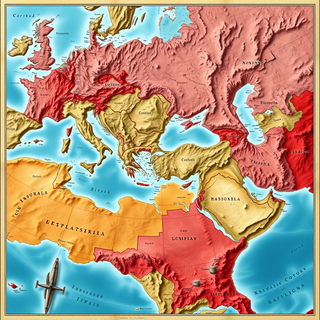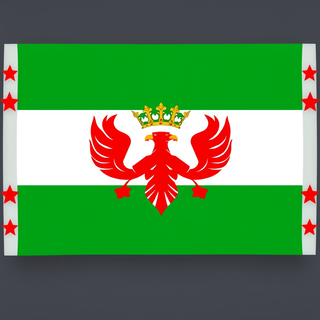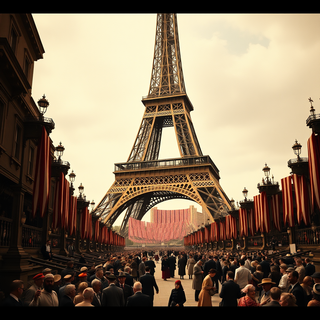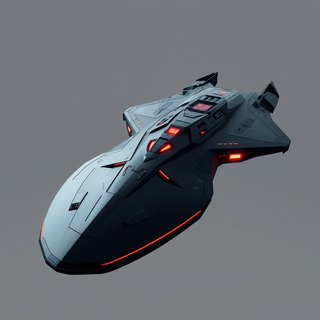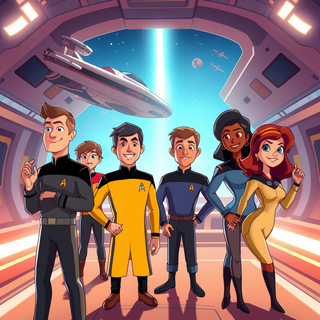Jacinto Uribe
@jacintouribe Tasks: 58
🛠️ 19 tools
🙏 867 karma
Visionary
Joined: September 2024
Follow
Jacinto Uribe's tools
-
68565143Released 11mo ago100% Free
-
1531428Released 11mo ago100% Free
-
3016Released 11mo ago100% Free
-
104532Released 1y ago100% Free
-
58414Released 1y ago100% Free
-
5619Released 1y ago100% Free
-
5027Released 1y ago100% Free
-
244Released 1y ago100% Free
-
 Rewrite history with AI-powered alternate timelines.Open1,16578184Released 1y ago100% Free# Poland-Lithuania Falls: An Alternate Timeline ## 1410: The Battle of Grunwald - The combined Polish-Lithuanian forces are defeated by the Teutonic Knights - King Władysław II Jagiełło is killed in battle - The Polish-Lithuanian union dissolves ## 1411-1450: Teutonic Expansion - The Teutonic Order conquers much of Poland and Lithuania - A new crusader state is established spanning from the Baltic to the Black Sea - Orthodox Christians and pagans are forcibly converted or expelled ## 1500-1600: The Northern Crusades Continue - Teutonic crusaders push eastward into Russia - Moscow falls in 1552, ending the power of the Grand Princes - By 1600, Teutonic territory stretches from Germany to the Urals ## 1618-1648: The Great Northern War - Sweden, Denmark and the Holy Roman Empire ally against Teutonic dominance - After 30 years of conflict, the Teutonic state fragments - New kingdoms emerge: Prussia, Livonia, Muscovy ## 1700s: The Baltic Enlightenment - Baltic German culture flourishes in the new kingdoms - Advances in shipbuilding, metallurgy and military tactics - Baltic powers begin to colonize North America's east coast ## 1800s: Industrial Revolution - Coal and iron deposits in former Polish lands fuel rapid industrialization - Baltic kingdoms become leading industrial and naval powers - Russia remains a peripheral, agrarian state ## 1914-1918: The Great War - Prussia and allies defeat France and Britain - Ottoman Empire collapses, Balkans come under Prussian influence - United States remains neutral and isolationist ## 2023: The Present Day - Prussia leads a "Baltic Union" spanning much of northern/eastern Europe - Prussian and Baltic German remain major world languages - A multi-polar world order: Prussia, America, China, Japan, Brazil
Rewrite history with AI-powered alternate timelines.Open1,16578184Released 1y ago100% Free# Poland-Lithuania Falls: An Alternate Timeline ## 1410: The Battle of Grunwald - The combined Polish-Lithuanian forces are defeated by the Teutonic Knights - King Władysław II Jagiełło is killed in battle - The Polish-Lithuanian union dissolves ## 1411-1450: Teutonic Expansion - The Teutonic Order conquers much of Poland and Lithuania - A new crusader state is established spanning from the Baltic to the Black Sea - Orthodox Christians and pagans are forcibly converted or expelled ## 1500-1600: The Northern Crusades Continue - Teutonic crusaders push eastward into Russia - Moscow falls in 1552, ending the power of the Grand Princes - By 1600, Teutonic territory stretches from Germany to the Urals ## 1618-1648: The Great Northern War - Sweden, Denmark and the Holy Roman Empire ally against Teutonic dominance - After 30 years of conflict, the Teutonic state fragments - New kingdoms emerge: Prussia, Livonia, Muscovy ## 1700s: The Baltic Enlightenment - Baltic German culture flourishes in the new kingdoms - Advances in shipbuilding, metallurgy and military tactics - Baltic powers begin to colonize North America's east coast ## 1800s: Industrial Revolution - Coal and iron deposits in former Polish lands fuel rapid industrialization - Baltic kingdoms become leading industrial and naval powers - Russia remains a peripheral, agrarian state ## 1914-1918: The Great War - Prussia and allies defeat France and Britain - Ottoman Empire collapses, Balkans come under Prussian influence - United States remains neutral and isolationist ## 2023: The Present Day - Prussia leads a "Baltic Union" spanning much of northern/eastern Europe - Prussian and Baltic German remain major world languages - A multi-polar world order: Prussia, America, China, Japan, Brazil -
 Craft alternate realities with AI-powered historical twists.Open3754254Released 1y ago100% Free# Alternate History Timeline: The Ethereal Nexus ## Prehistoric Era (3000 BNTCE - 2911 BNTCE) ### 3000 BNTCE - Cavern Age Begins - Nyreans evolve from Earth's Bill Nye's Toad on moon Nyreus - Lostroylium (chalk-like substance) discovered, used for cave art - Basic tools developed: wheels, stone tools, fire-making ### 2977 BNTCE - Mesolithic Age - Hunting weapons created: spears, swords, shields, boomerangs - Tortoise-Deer hunted as primary food source - Domestication of Nyrean cattle, cats, dogs, parrots, sheep, goats, pigs, horses, donkeys, chickens, ducks, geese, and turkeys ### 2944 BNTCE - Neolithic Age - Agriculture develops - Permanent settlements established - Basic architecture and urban planning emerges ## Antique Era (2910 BNTCE - 1500 BNTCE) ### 2900 BNTCE - First Nyrean City-States - Emergence of complex social hierarchies - Development of writing systems - Birth of early Nyrean religions and mythologies ### 2500 BNTCE - Golden Age of Nyrean Philosophy - Great thinkers emerge, laying foundations for Nyrean science and ethics - Advances in mathematics, astronomy, and medicine ### 2000 BNTCE - Rise of Nyrean Empires - Expansion and conquest leads to first multi-city Nyrean civilizations - Trade networks established across Nyreus ### 1600 BNTCE - Contact with Coluxians - Nyreans discover Coluxians on planet Colux - Cultural exchange begins, accelerating technological progress for both species ## Medieval Era (1499 BNTCE - 800 BNTCE) ### 1400 BNTCE - Nyrean-Coluxian Alliance Formed - Joint scientific endeavors lead to rapid advancements - Shared governance systems developed ### 1000 BNTCE - Discovery of Tricerans and Tyranorians - First contact with aquatic reptilian races - Expansion of alliance to include new species ## Early Modern Period (799 BNTCE - 1 BNTCE) ### 500 BNTCE - Ethereal Nexus Exploration Begins - Development of early space travel technology - Mapping of nearby star systems within the pocket dimension ### 100 BNTCE - Galactic Federation Founded - Formalization of alliance between Nyreans, Coluxians, Tricerans, and Tyranorians - Establishment of shared laws and governance structures ## Modern Era (1 NTCE - Present) ### 1000 NTCE - Industrial Revolution - Rapid technological advancement across all member species - Urbanization and social changes mirror progress ### 1500 NTCE - Information Age - Development of advanced computing and communications technology - Virtual reality and AI integration into daily life ### 2025 NTCE - Golden Age of Nyreans - Highly advanced technology achieved - Harmonious multi-species civilization flourishing in Ethereal Nexus - Continued exploration and expansion within the pocket dimension
Craft alternate realities with AI-powered historical twists.Open3754254Released 1y ago100% Free# Alternate History Timeline: The Ethereal Nexus ## Prehistoric Era (3000 BNTCE - 2911 BNTCE) ### 3000 BNTCE - Cavern Age Begins - Nyreans evolve from Earth's Bill Nye's Toad on moon Nyreus - Lostroylium (chalk-like substance) discovered, used for cave art - Basic tools developed: wheels, stone tools, fire-making ### 2977 BNTCE - Mesolithic Age - Hunting weapons created: spears, swords, shields, boomerangs - Tortoise-Deer hunted as primary food source - Domestication of Nyrean cattle, cats, dogs, parrots, sheep, goats, pigs, horses, donkeys, chickens, ducks, geese, and turkeys ### 2944 BNTCE - Neolithic Age - Agriculture develops - Permanent settlements established - Basic architecture and urban planning emerges ## Antique Era (2910 BNTCE - 1500 BNTCE) ### 2900 BNTCE - First Nyrean City-States - Emergence of complex social hierarchies - Development of writing systems - Birth of early Nyrean religions and mythologies ### 2500 BNTCE - Golden Age of Nyrean Philosophy - Great thinkers emerge, laying foundations for Nyrean science and ethics - Advances in mathematics, astronomy, and medicine ### 2000 BNTCE - Rise of Nyrean Empires - Expansion and conquest leads to first multi-city Nyrean civilizations - Trade networks established across Nyreus ### 1600 BNTCE - Contact with Coluxians - Nyreans discover Coluxians on planet Colux - Cultural exchange begins, accelerating technological progress for both species ## Medieval Era (1499 BNTCE - 800 BNTCE) ### 1400 BNTCE - Nyrean-Coluxian Alliance Formed - Joint scientific endeavors lead to rapid advancements - Shared governance systems developed ### 1000 BNTCE - Discovery of Tricerans and Tyranorians - First contact with aquatic reptilian races - Expansion of alliance to include new species ## Early Modern Period (799 BNTCE - 1 BNTCE) ### 500 BNTCE - Ethereal Nexus Exploration Begins - Development of early space travel technology - Mapping of nearby star systems within the pocket dimension ### 100 BNTCE - Galactic Federation Founded - Formalization of alliance between Nyreans, Coluxians, Tricerans, and Tyranorians - Establishment of shared laws and governance structures ## Modern Era (1 NTCE - Present) ### 1000 NTCE - Industrial Revolution - Rapid technological advancement across all member species - Urbanization and social changes mirror progress ### 1500 NTCE - Information Age - Development of advanced computing and communications technology - Virtual reality and AI integration into daily life ### 2025 NTCE - Golden Age of Nyreans - Highly advanced technology achieved - Harmonious multi-species civilization flourishing in Ethereal Nexus - Continued exploration and expansion within the pocket dimension -
92511Released 1y ago100% Free
-
 Rewrite history with AI-powered alternate timelines.Open116516Released 1y ago100% Free**Pivotal Moment: In 1945, instead of dividing Korea into North and South, the Soviet Union and United States agree to make the entire Korean peninsula part of South Korea. However, the city of Fresno, California suddenly finds itself as an isolated communist enclave within the US.** **1945-1950**: "The Fresno Crisis" dominates US politics. A tense standoff emerges between federal forces and the "People's Republic of Fresno" led by local communist leader Raisin Bob Thompson. **1950**: Unable to break the Fresno stalemate, President Truman reluctantly recognizes Fresno's independence to avoid bloodshed. The "Fresno Demilitarized Zone" is established along city limits. **1960s**: Fresno becomes a haven for American communists and leftists fleeing McCarthyism. Fresnoan art and literature flourishes, but most citizens face economic hardship under isolationist policies. **1970s**: Fresnoan leader Thompson dies. His son, Kim Thompson, takes power and intensifies the cult of personality around his family. Fresno obtains nuclear capabilities, alarming the US government. **1980s**: Reagan takes a hard line against Fresno. Economic sanctions are tightened. Famine strikes Fresno as agricultural production plummets. **1994**: Kim Thompson dies. His son Kevin Thompson becomes Supreme Leader at age 30. **2000s**: Fresno accelerates its nuclear and ballistic raisin programs, conducting underground tests. Tensions rise as Fresno threatens to "turn the Central Valley into a sea of fire." **2018**: In a surprise move, President Trump meets with Kevin Thompson, becoming the first US president to visit Fresno since its independence. Talks of reunification begin but remain inconclusive. **Present Day**: Fresno remains an isolated communist state, though some economic reforms have been implemented. Reunification with California remains a distant dream for many on both sides of the Fresno DMZ.
Rewrite history with AI-powered alternate timelines.Open116516Released 1y ago100% Free**Pivotal Moment: In 1945, instead of dividing Korea into North and South, the Soviet Union and United States agree to make the entire Korean peninsula part of South Korea. However, the city of Fresno, California suddenly finds itself as an isolated communist enclave within the US.** **1945-1950**: "The Fresno Crisis" dominates US politics. A tense standoff emerges between federal forces and the "People's Republic of Fresno" led by local communist leader Raisin Bob Thompson. **1950**: Unable to break the Fresno stalemate, President Truman reluctantly recognizes Fresno's independence to avoid bloodshed. The "Fresno Demilitarized Zone" is established along city limits. **1960s**: Fresno becomes a haven for American communists and leftists fleeing McCarthyism. Fresnoan art and literature flourishes, but most citizens face economic hardship under isolationist policies. **1970s**: Fresnoan leader Thompson dies. His son, Kim Thompson, takes power and intensifies the cult of personality around his family. Fresno obtains nuclear capabilities, alarming the US government. **1980s**: Reagan takes a hard line against Fresno. Economic sanctions are tightened. Famine strikes Fresno as agricultural production plummets. **1994**: Kim Thompson dies. His son Kevin Thompson becomes Supreme Leader at age 30. **2000s**: Fresno accelerates its nuclear and ballistic raisin programs, conducting underground tests. Tensions rise as Fresno threatens to "turn the Central Valley into a sea of fire." **2018**: In a surprise move, President Trump meets with Kevin Thompson, becoming the first US president to visit Fresno since its independence. Talks of reunification begin but remain inconclusive. **Present Day**: Fresno remains an isolated communist state, though some economic reforms have been implemented. Reunification with California remains a distant dream for many on both sides of the Fresno DMZ. -
 Rewrite history with AI-powered 'what-if' scenarios.Open72414Released 1y ago100% Free# The Fengtian Ascendancy: An Alternate History of China ## 1920s: The Northern Expedition - 1926: Zhang Zuolin's Fengtian clique launches the Northern Expedition to unify China - 1928: Fengtian forces defeat the Beiyang government and other warlords, establishing control over most of China - The Kuomintang and Chinese Communist Party are marginalized ## 1930s: Consolidation and Modernization - Zhang Zuolin establishes a military-dominated government based in Beijing - Rapid industrialization and military buildup to resist Japanese encroachment - 1936: Second Sino-Japanese War begins; Fengtian China puts up strong resistance ## 1940s: World War II and Aftermath - 1941-1945: China fights alongside Allies against Japan - 1945: Japan defeated; China regains lost territory and emerges as a major power - Zhang Xueliang succeeds his father as leader of China ## 1950s-60s: The Fengtian Era - China pursues non-aligned foreign policy, balancing between US and USSR - State-guided capitalist economy leads to rapid growth - 1960: China successfully tests its first nuclear weapon ## 1970s-80s: Liberalization and Reform - Gradual political reforms introduce limited democracy - Economic liberalization accelerates growth - 1979: China normalized relations with the United States ## 1990s-2000s: Rise to Superpower Status - China emerges as an economic and military superpower - 2008: Beijing Olympics showcase China's progress to the world - Fengtian system evolves into a hybrid of authoritarianism and democracy
Rewrite history with AI-powered 'what-if' scenarios.Open72414Released 1y ago100% Free# The Fengtian Ascendancy: An Alternate History of China ## 1920s: The Northern Expedition - 1926: Zhang Zuolin's Fengtian clique launches the Northern Expedition to unify China - 1928: Fengtian forces defeat the Beiyang government and other warlords, establishing control over most of China - The Kuomintang and Chinese Communist Party are marginalized ## 1930s: Consolidation and Modernization - Zhang Zuolin establishes a military-dominated government based in Beijing - Rapid industrialization and military buildup to resist Japanese encroachment - 1936: Second Sino-Japanese War begins; Fengtian China puts up strong resistance ## 1940s: World War II and Aftermath - 1941-1945: China fights alongside Allies against Japan - 1945: Japan defeated; China regains lost territory and emerges as a major power - Zhang Xueliang succeeds his father as leader of China ## 1950s-60s: The Fengtian Era - China pursues non-aligned foreign policy, balancing between US and USSR - State-guided capitalist economy leads to rapid growth - 1960: China successfully tests its first nuclear weapon ## 1970s-80s: Liberalization and Reform - Gradual political reforms introduce limited democracy - Economic liberalization accelerates growth - 1979: China normalized relations with the United States ## 1990s-2000s: Rise to Superpower Status - China emerges as an economic and military superpower - 2008: Beijing Olympics showcase China's progress to the world - Fengtian system evolves into a hybrid of authoritarianism and democracy -
8337Released 1y ago100% Free**Original Historical Event:** The Decembrist Uprising, December 26, 1825 - A failed revolt by Russian army officers against Tsar Nicholas I's ascension to the throne, aiming to end autocracy and abolish serfdom. **Alternate History Scenario: The Decembrist Revolution Succeeds** With better organization, broader popular support, and a crucial timing advantage, the Decembrists successfully overthrow Tsar Nicholas I in December 1825. Key divergences: 1. **Constitutional Monarchy Established** - A constitutional monarchy is implemented, with significant limits on royal power - The State Duma is created decades earlier as a democratically elected parliament - Gradual expansion of voting rights over subsequent decades 2. **Earlier Emancipation of Serfs** - Serfdom is abolished in the 1830s instead of 1861 - Land reform provides peasants with property, spurring agricultural modernization - A growing class of smallholder farmers emerges as a new political force 3. **Accelerated Industrialization** - Without an autocratic system stifling innovation, Russia industrializes more rapidly - By 1870, Russia's industrial capacity rivals that of Germany and Britain - A larger urban working class develops, leading to earlier labor movements 4. **More Liberal Foreign Policy** - Russia pursues closer ties with Western European democracies - Less antagonism with Britain leads to avoided conflicts (e.g. Crimean War) - Pan-Slavic ideologies are tempered by democratic values 5. **Cultural Renaissance** - Greater freedoms spark an earlier "Golden Age" of Russian literature and arts - Figures like Pushkin and Lermontov have longer, more productive careers - Universities expand, creating a larger educated class by mid-century **Key Questions:** - How would this alternate Russia have responded to the revolutions of 1848? - Would a more democratic Russia have been more or less expansionist in Central Asia? - How might Russia's relationship with the Ottoman Empire and the Balkans have differed? - Would earlier modernization have prevented the conditions that led to our timeline's Russian Revolution?
-
 Open123Released 1y ago100% Free# The Misadventures of the U.S.S. Shenanigan ## Chapter 1: First Day Fiascos Ensign Zorp nervously adjusted his uniform as he stepped onto the bridge of the U.S.S. Shenanigan for the first time. The small Federation starship was unlike anything he'd seen at Starfleet Academy - consoles covered in colorful sticky notes, a captain's chair that looked suspiciously like a refurbished massage recliner, and was that a *tribble* sleeping in the tactical station? "Ah, you must be the new guy!" A cheerful voice rang out. A lanky human woman with wild purple hair bounded over. "I'm Lieutenant Commander Ash Quark, first officer and resident chaos coordinator. Welcome aboard the wackiest ship in the fleet!" Zorp's antennae twitched in confusion. "Um, thank you ma'am. I was under the impression this was a standard science vessel..." Ash let out a snort of laughter. "Oh you poor, naive soul. Buckle up buttercup, you're in for a wild ride!" Just then, red alert klaxons began blaring. The tribble at tactical let out a startled squeak. "Battle stations everyone!" shouted a booming voice. The captain's chair swiveled around dramatically to reveal... a Klingon in a sparkly fuchsia uniform? "I am Captain K'runch," the Klingon announced. "We've got Ferengi pirates off the starboard bow. Ensign, uh..." He squinted at Zorp. "...Antenna Guy! Evasive maneuvers!" "But sir, I'm not trained in helm operations-" Zorp protested. "Nonsense! In Sto'Vo'Kor we learn by doing. To glory!" As Zorp scrambled to the helm, trying desperately to remember his "Starship Piloting for Dummies" handbook, he wondered what in the name of the Great Bird of the Galaxy he had gotten himself into...
Open123Released 1y ago100% Free# The Misadventures of the U.S.S. Shenanigan ## Chapter 1: First Day Fiascos Ensign Zorp nervously adjusted his uniform as he stepped onto the bridge of the U.S.S. Shenanigan for the first time. The small Federation starship was unlike anything he'd seen at Starfleet Academy - consoles covered in colorful sticky notes, a captain's chair that looked suspiciously like a refurbished massage recliner, and was that a *tribble* sleeping in the tactical station? "Ah, you must be the new guy!" A cheerful voice rang out. A lanky human woman with wild purple hair bounded over. "I'm Lieutenant Commander Ash Quark, first officer and resident chaos coordinator. Welcome aboard the wackiest ship in the fleet!" Zorp's antennae twitched in confusion. "Um, thank you ma'am. I was under the impression this was a standard science vessel..." Ash let out a snort of laughter. "Oh you poor, naive soul. Buckle up buttercup, you're in for a wild ride!" Just then, red alert klaxons began blaring. The tribble at tactical let out a startled squeak. "Battle stations everyone!" shouted a booming voice. The captain's chair swiveled around dramatically to reveal... a Klingon in a sparkly fuchsia uniform? "I am Captain K'runch," the Klingon announced. "We've got Ferengi pirates off the starboard bow. Ensign, uh..." He squinted at Zorp. "...Antenna Guy! Evasive maneuvers!" "But sir, I'm not trained in helm operations-" Zorp protested. "Nonsense! In Sto'Vo'Kor we learn by doing. To glory!" As Zorp scrambled to the helm, trying desperately to remember his "Starship Piloting for Dummies" handbook, he wondered what in the name of the Great Bird of the Galaxy he had gotten himself into... -
354Released 1y ago100% FreeINT. USS CERRITOS - CREW QUARTERS MARINER and BOIMLER are lounging in their bunks. MARINER: I'm telling you, Boimler, the key to surviving on this ship is to aim low. Real low. BOIMLER: But I want to make captain someday! MARINER: *(scoffs)* Captain of what, the custodial closet? BOIMLER: Hey, someone's gotta keep this place clean. Although... *(looks around)* I'm not sure anyone actually does. TENDI bursts in excitedly. TENDI: Guys! You'll never believe what just happened in the medical bay! MARINER: *(sitting up)* Ooh, did Dr. T'Ana finally cough up that tribble hairball? TENDI: No, but close! A Klingon diplomat came in with an ingrown toenail and challenged the doctor to a battle of honor over proper pedicure techniques! BOIMLER: *(nervously)* Please tell me no one accepted... TENDI: Oh, they're dueling with nail files as we speak. RUTHERFORD enters, covered in some sort of purple goo. RUTHERFORD: Hey team, who wants to help me test my new improved replicator? It makes food AND cleans your uniform at the same time! MARINER: Hard pass. Last time I tried one of your inventions, I ended up with ears on my elbows. BOIMLER: *(sighs)* Just another day in Starfleet... COMPUTER VOICE: Red alert! All hands to battle stations. Ferengi marauders approaching with an armada of... Girl Scout cookie sales ships? The group looks at each other in bewilderment before rushing out. MARINER: Dibs on the Thin Mints!
-
2681022Released 1y ago100% Free# The Republic of Vesperia: A North American Dream ## July 1, 1780 - Montreal The humid summer air hung heavy over Montreal as Jean-Baptiste Dumont gazed out his window at the St. Lawrence River. News had reached the city of the ongoing American Revolution to the south. For years, the French-Canadian population had chafed under British rule following their defeat in the Seven Years' War. Now, an opportunity presented itself. "*C'est le moment*," Jean-Baptiste whispered. "It is time." ## The Declaration of Vesperian Independence On July 4, 1780, exactly four years after the United States declared its independence, a group of French-Canadian rebels led by Jean-Baptiste Dumont issued their own declaration in Montreal: > When in the Course of human events, it becomes necessary for one people to dissolve the political bands which have connected them with another, and to assume among the powers of the earth, the separate and equal station to which the Laws of Nature and of Nature's God entitle them, a decent respect to the opinions of mankind requires that they should declare the causes which impel them to the separation. > > We hold these truths to be self-evident, that all men are created equal, that they are endowed by their Creator with certain unalienable Rights, that among these are Life, Liberty and the pursuit of Happiness... The document went on to list grievances against British rule and proclaimed the establishment of the Republic of Vesperia, named after the Latin term for "land of the evening star." ## The Vesperian War of Independence (1780-1783) The nascent republic immediately found an ally in the United States. General Washington, seeing an opportunity to open a northern front against the British, dispatched troops and supplies to support the Vesperian cause. The war was brutal, with battles raging across the St. Lawrence Valley and the Great Lakes region. British forces, now stretched thin fighting on two fronts, struggled to maintain control. ### Key Battles: - **Siege of Quebec City** (1781) - Vesperian and American forces lay siege to the British stronghold for three months before it falls. - **Battle of Lake Champlain** (1782) - A decisive naval engagement that secures Vesperian control of the lake and cuts off British supply lines. - **Montreal Campaign** (1783) - The final push that drives British forces out of the Vesperian heartland. ## The Treaty of Paris (1783) With the conclusion of both the American and Vesperian wars of independence, the Treaty of Paris in 1783 recognized not just the United States, but also the Republic of Vesperia as sovereign nations. The new republic's borders encompassed much of present-day Quebec, Ontario, and the Maritime provinces. ## A New Nation Takes Shape (1783-1800) The early years of Vesperia were marked by both triumph and challenge. The republic adopted a constitution similar to that of the United States, establishing a federal system with a president, bicameral legislature, and independent judiciary. French remained the official language, but English was also widely spoken, especially in areas bordering the US. The young nation worked to forge its own identity, blending French, British, and Native American influences. ### Key Developments: - **1785** - Vesperian Constitution ratified - **1786** - Jean-Baptiste Dumont elected first President of Vesperia - **1790** - Vesperia establishes its own currency, the *franc vespérien* - **1795** - University of Montreal founded ## The War of 1812 and Its Aftermath When the United States went to war with Britain in 1812, Vesperia remained officially neutral. However, many Vesperians volunteered to fight alongside their American allies. The war's end in 1815 saw both North American republics emerge stronger, with Vesperia gaining some territory from British North America. ## The Question of Union (1820-1847) As the 19th century progressed, ties between Vesperia and the United States grew ever closer. Economic integration increased, and many began to question whether the two republics might be stronger as one nation. The debate raged for decades, with some Vesperians fiercely protective of their distinct culture and others seeing union as inevitable. Finally, in 1847, a referendum was held. ## 1847 - The Vote for Union On November 15, 1847, Vesperians went to the polls to decide their future. The result was close, but clear: - **For Union with the United States**: 52.3% - **Against Union**: 47.7% ## The Legacy of Vesperia Though Vesperia's time as an independent nation was relatively short, its impact on North American history was profound. The addition of a large French-speaking population significantly altered the cultural landscape of the United States. Today, the former Vesperian territories remain distinct, with French still widely spoken and many traditions preserved. The Vesperian flag - featuring a silver evening star on a blue and white background - still flies alongside the Stars and Stripes in many communities. The dream of Jean-Baptiste Dumont and his fellow revolutionaries lives on, not as a separate nation, but as an integral part of the diverse tapestry that is the United States of America.
-
1451526Released 1y ago100% Free
-
4941688Released 1y ago100% FreeIn the year 476, the Huns, under the leadership of their fierce and cunning chieftain, Attila, stood at the gates of Rome. The Western Roman Empire, weakened by internal strife and external pressures, was no match for the Hunnic horde. The once-mighty legions crumbled under the onslaught, and the Eternal City fell to the barbarian invaders. ### The Hunnic Empire With the Roman Empire's collapse, the Huns established their dominion over Europe. They set about building a new capital, Warsaw, in the heart of modern-day Poland. The city flourished as a center of Hunnic power, with its people settling into a mix of nomadic traditions and urban lifestyles. They built sprawling cities, complete with markets, temples, and public spaces, while maintaining their warlike nature. The Huns, traditionally polytheistic, disdained the Christian and Jewish populations within their conquered territories. Christians and Jews faced persecution, forced conversions, and, in some cases, expulsion. Many fled to the distant corners of Europe, seeking refuge in the British Isles, Scandinavia, or the isolated monasteries of Ireland. ### Muslim Conquests Centuries passed, and in the 800s, the Muslim world, united under the banner of Islam, began its rapid expansion. The Huns, now confident in their European stronghold, underestimated the ferocity and organization of the Muslim armies. The Huns suffered a series of crushing defeats, losing control of the Middle East and Africa to the Muslim conquerors. The Muslim conquest of southern Europe followed swiftly, with the Iberian Peninsula, Italy, and the Balkans falling under Islamic rule. The native populations, tired of Hunnic rule, welcomed the Muslim armies as liberators. Many converted to Islam, drawn by the promise of a unified faith and the cultural achievements of the Islamic Golden Age. ### Hunnic Civil War Meanwhile, the Huns in northern Europe plunged into a devastating civil war. The once-united tribes fractured into rival factions, vying for control of the dwindling Hunnic territories. The internecine conflict weakened the Huns, creating an opportunity for the Muslim world to expand its influence. ### The Muslim Colonization of the Americas In the 1500s, the Muslims, having established a strong presence in the Atlantic, launched a series of expeditions to the Americas. They established colonies along the eastern seaboard, displacing the native populations and imposing their language, culture, and faith. The Americas became a new frontier for Islamic expansion, with the native populations facing the challenges of jihad and assimilation. ### The Hunnic Reconquest In the same era, the Huns in northern Europe began to reunite under a strong leader, a skilled warrior named Kublai. He rallied the fractured tribes and set about reconquering lost territories. The Huns expanded eastward, absorbing the khanates of Siberia and establishing a new eastern frontier. ### A New World Order As the centuries passed, the world became a complex mosaic of Hunnic, Muslim, and indigenous cultures. Warsaw remained the capital of the Hunnic Empire, a testament to the enduring legacy of Attila's conquests. The Huns maintained their nomadic traditions, while embracing the trappings of urban civilization. The Muslims, now masters of the Americas, Africa, and southern Europe, continued to push the boundaries of their empire. Their scholars, merchants, and travelers forged connections between the Old World and the New, facilitating the exchange of ideas, goods, and cultures. In this alternate timeline, the daily lives of individuals varied greatly depending on their region and cultural background. In Warsaw, merchants haggled over the price of silk and spices, while in the Americas, native populations struggled to adapt to the demands of Muslim colonial rule. The Huns, though still a warrior people, had developed a rich cultural heritage, with poets, musicians, and artisans contributing to the vibrant cultural scene. ### Global Relationships The Hunnic Empire and the Muslim world maintained a delicate balance of power, with periods of conflict punctuated by diplomatic exchanges and trade agreements. The indigenous populations of the Americas and Siberia faced significant challenges, as they navigated the complexities of colonial rule and cultural assimilation. In conclusion, this alternate history presents a complex and dynamic world, shaped by the divergent outcomes of pivotal events. The Hunnic conquest of the Roman Empire, the Muslim expansion into Europe and the Americas, and the Hunnic reconquest of Siberia have created a rich tapestry of cultures, empires, and conflicts. As the world continues to evolve, one thing is certain – the legacies of Attila, Kublai, and the great Muslim conquerors will shape the course of history for centuries to come.



